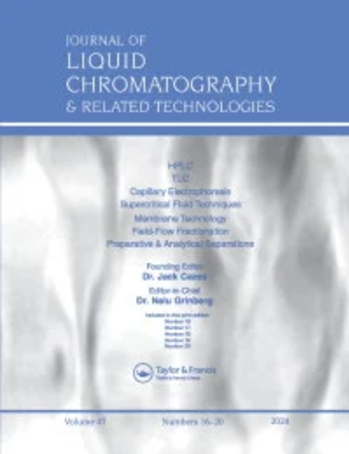使用顺序注射毛细管电泳非接触式电导检测(SI-CE-C4D)自动在线监测三苯氧胺耐药MCF-7细胞中的乳酸和丙酮酸盐及其与MCT1和MCT4基因表达的相关性
IF 1.2
4区 化学
Q4 BIOCHEMICAL RESEARCH METHODS
Journal of Liquid Chromatography & Related Technologies
Pub Date : 2022-02-25
DOI:10.1080/10826076.2022.2098760
引用次数: 0
摘要
摘要癌症是世界上最常见的癌症类型之一。女性癌症不同阶段的一线和二线治疗方案依赖于他莫昔芬。到目前为止,人们还不完全了解三苯氧胺耐药性的发展。在本研究中,开发了一种具有电容耦合非接触式电导率检测器的自动顺序注射毛细管电泳,用于在线监测MCF-7细胞产生三苯氧胺耐药性的上清液培养基中的乳酸和丙酮酸水平。从三个模型细胞培养物和两个对照未处理细胞中同时监测两种代谢物的浓度变化。电泳分离是在反向电渗流条件下进行的。该系统在20的低样本消耗下提供高样本吞吐量 每次分析µL。该方法具有较强的鲁棒性,具有较高的灵敏度和分辨率。检测限分别为8.0和17.0 nM和线性范围分别为0.15–5和0.01–1 乳酸和丙酮酸的相关系数分别为0.9951和0.9963。批间和批内准确度在95.37–107.02%之间,精密度(RSD,%)≤9.84%。该方法经过了完全验证,获得的数据与使用乳酸和丙酮酸测定试剂盒获得的结果一致。所产生的信息丰富的数据显示,与两个对照细胞相比,三个三苯氧胺抗性MCF-7细胞模型中的乳酸和丙酮酸产量从5.8开始显著增加 小时和6.8 培养时间分别为小时。乳酸盐和丙酮酸盐浓度的增加与MCT1和MCT4基因表达的增加相关。图形摘要本文章由计算机程序翻译,如有差异,请以英文原文为准。
Automated online monitoring of lactate and pyruvate in tamoxifen resistant MCF-7 cells using sequential-injection capillary electrophoresis with contactless conductivity detection (SI-CE-C4D) and correlation with MCT1 and MCT4 genes expression
Abstract Breast cancer is among the most common cancer types worldwide. The first and second line treatment protocols for various stages of breast cancer in females rely on tamoxifen. Until now, the development of tamoxifen resistance is not entirely understood. In this study, an automated sequential injection capillary electrophoresis with capacitively coupled contactless conductivity detector was developed for online levels monitoring of both lactate and pyruvate from the supernatant media of MCF-7 cells developing tamoxifen resistance. Changes in concentration of the two metabolites were simultaneously monitored from three model cell cultures and two control untreated cells. The electrophoretic separation was performed under reversed electroosmotic flow conditions. The system delivers high sample throughput at low sample consumption of 20 µL per analysis. The method is robust and achieved high sensitivity and resolution. Limits of detection were 8.0 and 17.0 nM and linear ranges were 0.15–5 and 0.01–1 mM with a correlation coefficient of 0.9951 and 0.9963 for lactate and pyruvate, respectively. Inter-run and intra-run accuracy were in the range of 95.37–107.02% with precision (RSD, %) of ≤9.84%. The method was completely validated and the data obtained were in agreement with results achieved using the lactate and pyruvate assay kits. The highly informative generated data revealed a significant increase in lactate and pyruvate production in the three tamoxifen resistant MCF-7 cells models compared to the two control cells starting from 5.8 hours and 6.8 hours culturing times, respectively. The increase in concentrations of both lactate and pyruvate were correlated with an increase in MCT1 and MCT4 genes expression. Graphical abstract
求助全文
通过发布文献求助,成功后即可免费获取论文全文。
去求助
来源期刊
CiteScore
2.80
自引率
0.00%
发文量
29
审稿时长
4.9 months
期刊介绍:
The Journal of Liquid Chromatography & Related Technologies is an internationally acclaimed forum for fast publication of critical, peer reviewed manuscripts dealing with analytical, preparative and process scale liquid chromatography and all of its related technologies, including TLC, capillary electrophoresis, capillary electrochromatography, supercritical fluid chromatography and extraction, field-flow technologies, affinity, and much more. New separation methodologies are added when they are developed. Papers dealing with research and development results, as well as critical reviews of important technologies, are published in the Journal.

 求助内容:
求助内容: 应助结果提醒方式:
应助结果提醒方式:


